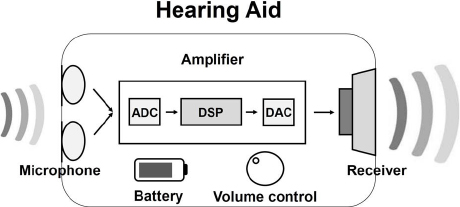Hanyang Med Rev.
2015 May;35(2):97-102. 10.7599/hmr.2015.35.2.97.
Rehabilitation of Sensorineural Hearing Loss: Hearing Aid
- Affiliations
-
- 1Department of Otorhinolaryngology-Head and Neck Surgery, Hanyang University Guri Hospital, Guri, Korea. Jaeho.chung.md@gmail.com
- KMID: 1793738
- DOI: http://doi.org/10.7599/hmr.2015.35.2.97
Abstract
- Social concerns about sensorineural hearing loss have been increasing with the advent of an aging society. As most hearing loss is incurable and permanent, audiologic rehabilitation is the only option for restoring hearing. Sensorineural hearing loss includes both sensory loss of the cochlea and functional loss of the 8th cranial nerve. Because sensorineural hearing loss patients often have difficulty in understanding and locating specific sounds amidst the other ambient noise, functional amplification with hearing aids in sensorineural hearing loss is challenging work. By applying digital signal processing techniques to hearing aids, hearing rehabilitation has undergone remarkable development in recent years. Herein, the basic concepts underlying digital signal processing are reviewed briefly, followed by a short historical background of hearing aid development. The principles of hearing aid selection, counselling, frequent problems encountered in hearing aid fitting and validation are also discussed.
Keyword
MeSH Terms
Figure
Cited by 2 articles
-
Etiology and Rehabilitation of Sensorineural Hearing Loss
Seung Hwan Lee
Hanyang Med Rev. 2015;35(2):55-56. doi: 10.7599/hmr.2015.35.2.55.Clinical Usefulness of Speech Mapping for Fitting of Hearing Aids
So Yean Kim, Jin Su Park, Min-Beom Kim
Korean J Otorhinolaryngol-Head Neck Surg. 2018;61(6):287-294. doi: 10.3342/kjorl-hns.2017.00668.
Reference
-
1. Choi J, Chung WH. Age-related hearing loss and the effects of hearing aids. J Korean Med Assoc. 2011; 54:918–924.
Article2. Dillon H. Hearing aids. 2nd ed. Sydney: Boomerang press;2012.3. The Korean Otology Society. Current Opinion on Hearing Aid. Seoul: Koonja;2012.4. Hong NP. Hearing Aid Candidacy and Selection Criteria. Korean J Audiol. 1998; 2:10–16.5. Palmer CV. A contemporary review of hearing aids. Laryngoscope. 2009; 119:2195–2204.
Article6. Cornelisse LE, Seewald RC, Jamieson DG. The input/output formula: a theoretical approach to the fitting of personal amplification devices. J Acoust Soc Am. 1995; 97:1854–1864.
Article7. Byrne D, Dillon H, Ching T, Katsch R, Keidser G. NAL-NL1 procedure for fitting nonlinear hearing aids: characteristics and comparisons with other procedures. J Am Acad Audiol. 2001; 12:37–51.
Article8. Plyler PN, Lowery KJ, Hamby HM, Trine TD. The objective and subjective evaluation of multichannel expansion in wide dynamic range compression hearing instruments. J Speech Lang Hear Res. 2007; 50:15–24.
Article9. McCreery RW, Venediktov RA, Coleman JJ, Leech HM. An evidence-based systematic review of directional microphones and digital noise reduction hearing aids in school-age children with hearing loss. Am J Audiol. 2012; 21:295–312.
Article10. Dreschler WA, Keidser G, Convery E, Dillon H. Client-based adjustments of hearing aid gain: the effect of different control configurations. Ear Hear. 2008; 29:214–227.
Article11. Smith P, Davis A. The benefits of using bluetooth accessories with hearing aids. Int J Audiol. 2014; 53:770–773.
Article12. Lewis MS, Hutter M, Lilly DJ, Bourdette D, Saunders J, Fausti SA. Frequency-modulation (FM) technology as a method for improving speech perception in noise for individuals with multiple sclerosis. J Am Acad Audiol. 2006; 17:605–616.
Article13. Kim HH, Barrs DM. Hearing aids: a review of whats new. Otolaryngol Head Neck Surg. 2006; 134:1043–1050.
Article14. Macrae JH, Dillon H. Gain, frequency response, and maximum output requirements for hearing aids. J Rehabil Res Dev. 1996; 33:363–376.15. Haggard M, Gatehouse S. Candidature for hearing aids: justification for the concept and a two-part audiometric criterion. Br J Audiol. 1993; 27:303–318.
Article16. Weinstein BE, Ventry IM. Audiometric correlates of the Hearing Handicap Inventory for the elderly. J Speech Hear Disord. 1983; 48:379–384.
Article17. Cho YS. Management of Hearing Aids Clinic. Korean J Otorhinolaryngol-Head Neck Surg. 2010; 53:333–339.
Article18. Palmer CV, Ortmann A. Hearing loss and hearing aids. Neurol Clin. 2005; 23:901–918. viii.
Article19. Kiessling J, Brenner B, Jespersen CT, Groth J, Jensen OD. Occlusion effect of earmolds with different venting systems. J Am Acad Audiol. 2005; 16:237–249.
Article20. Lee J, Lee KW. Breakthroughs in Hearing Aid Technology and Rehabilitation. Korean J Audiol. 2008; 12:145–151.
- Full Text Links
- Actions
-
Cited
- CITED
-
- Close
- Share
- Similar articles
-
- Etiology and Rehabilitation of Sensorineural Hearing Loss
- Sensorineural Hearing Loss: Causes and Hearing Rehabilitation
- The Characteristics and the Changes of Tinnitus according to the Recovery of Hearing Loss in the Patients with Sudden Hearing Loss
- Update on the Management for Sensorineural Hearing Loss in Children
- Cochleovestibular Otosclerosis Without Conductive Hearing Loss



